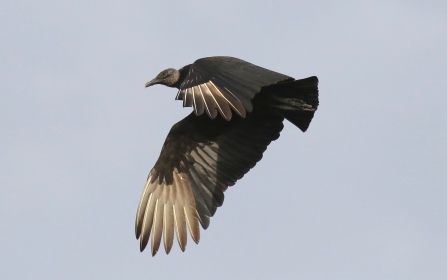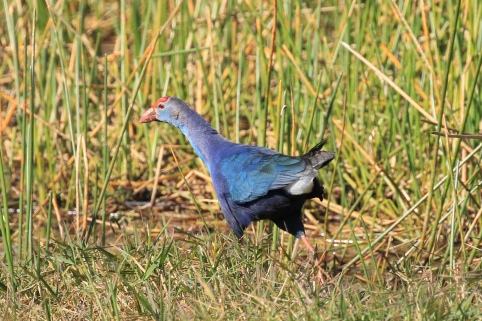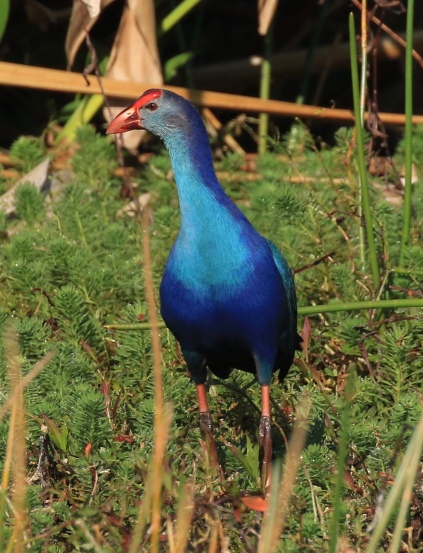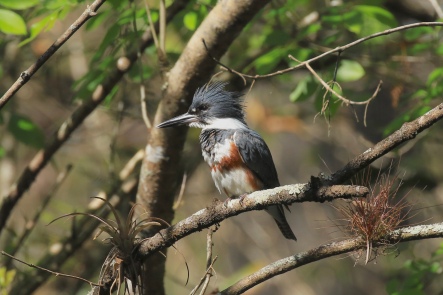Harns isn’t listed with the famous birding destinations in south Florida (Corkscrew, Ding Darling, the Everglades, and Big Cypress) but maybe it should be. This is a 578 acre preserve in Lehigh Acres set aside in 1985 for stormwater control along the Orange River. Half is an open water lake but the more interesting half for birders is the shallower marsh and surrounding trail. If you bird in the morning the sun will be at your back and allow some great shots of the waders and flyovers. Bring a scope as many of the birds tease you from a distance.
In my experience Harns is the best place to see Snail Kites. The imposing Sandhill Cranes approached me so closely I was a little worried about their intention, but it did allow some great closeups. The abundant non-native Apple Snails also attract Limpkins, while Bald Eagles, Harriers, Red-shouldered Hawks, Bitterns, and Vultures galore complemented the usual Florida waders. My personal life list here is 37, but locals report up to 100 species at Harns.
The reason for our recent visit was to chase the unusual Grey-headed swamphen (Porphyrio poliocephalus), listed on eBird as a rarity at this location. “Porphyrio” is Greek for purple, “polio” is Greek for grey, and “cephalus” is Latin for head. I had previously seen the bird only once at great distance and it was a life bird for my colleague. The large purple and blue bird was easily spotted among the grasses almost as soon as we arrived. The grey head was subtle if present at all. Apparently it is most obvious on the male; the female head is blue.
The swamphen saga in Florida is either one of escape and survival, or invasion and alarm depending on your point of view. The Purple swamphen is a native of Turkey, India, China, and Thailand and has recently been split into 6 separate species, the Grey-headed being one. There are two stories of the origin of this large tropical rail in south Florida. One account claims they escaped from the Miami Metro Zoo during hurricane Andrew in 1992. The other story blames careless aviculturalists allowing them to roam freely in Pembroke, Florida at about the same time. In any case the birds were sprung and made the most of their new freedom.
This bird has been described as “a Purple Gallinule on steroids”, it being much larger but otherwise quite similar to its native cousin. The non-migratory rail has quickly adjusted to the good life in the freshwater marshes of sunny Florida, primarily feasting on plants and supplementing the diet with mollusks, and small animals.
Up the food chain their threats are from alligators, large mammals, birds-of-prey, and for a while, man. The swamphens often raise several broods a year and their population has grown. With some alarm regarding their potential threats to the natives, authorities started a program of eradication, shooting 3100 birds over 27 months. This campaign ended in 2008 with the birds still surviving and thriving.
What do you think about the non-natives moving in? My feelings are colored by the Mute Swans that almost took over our tributary of the Chesapeake Bay several years ago. At their peak I could count several hundred of these alien, aggressive, non-migratory birds on the river with multiple nest along the shoreline. They were displacing the native, migratory, and more humble Tundra Swans and devouring the vital submerged grasses, roots and all. They clearly went too far when they attacked us in our canoe, (I fended them off with the paddle), and played chicken with me on the riding mower. Thankfully an eradication program ended all this and I have not seen one on the Chesapeake in years.
The jury’s still out on the swamphen. Can they assimilate and play well with others, or will they follow the lead of the Mute Swans and try to take over and dominate the Florida marshes? The bird is clearly a survivor. I admire that and so far I am not aware they have caused any substantial damage, but only time will tell. In the meantime, check out this photogenic bird and the other avifauna at Harns Marsh Preserve.








